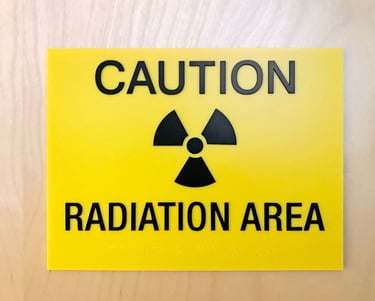February 2023
Radiation Protection in Veterinary Medicine
This article will give you a brief overview on radiation and how to protect yourself and your patients to minimize exposure. It will also give you two titles that should be in EVERY veterinary hospital library.


This post may have affiliate links. As an Amazon Associate, we earn from qualifying purchases from those links. This does not cost you anything and helps support the Sanctuary and all the animals in our care. This has no bearing on our reviews and comparisons. We will do our best to keep things fair and balanced to assist you in making the best decision for you and your pets.
Radiation shielding and personal protective equipment (PPE) is an essential part of any veterinary practice that uses ionizing radiation for diagnostic or therapeutic purposes. The use of ionizing radiation can pose a significant risk to both the animal patients and the veterinary staff, so it is critical to ensure that appropriate shielding measures are in place to protect everyone involved. In this article, we will discuss the importance of checking radiation shielding in veterinary medicine and the steps that can be taken to maintain a safe environment for all.
Why is radiation shielding important in veterinary medicine? Radiation is a form of energy that can cause damage to living tissue. Ionizing radiation, in particular, has enough energy to ionize atoms and molecules, leading to chemical changes in the body that can damage or kill cells. This can result in radiation sickness, cancer, or other long-term health effects. In veterinary medicine, ionizing radiation is commonly used for diagnostic imaging, such as X-rays or CT scans, and for cancer treatment with radiation therapy.
The use of ionizing radiation in veterinary medicine is a crucial tool for diagnosis and treatment, but it is essential to minimize the risk of radiation exposure to the patient, the veterinary staff, and the general public. While utilizing hands-free techniques are the "gold standard," shielding remains the an effective way to protect individuals from radiation exposure. The use of appropriate shielding materials, such as lead or concrete, can reduce radiation exposure levels and limit the spread of radiation beyond the immediate area of use. The shielding must be designed, installed, and maintained properly to ensure its effectiveness.
What are the risks of inadequate radiation shielding in veterinary medicine? Inadequate radiation shielding can result in several risks to animal patients and especially veterinary staff. Veterinary staff that are exposed to radiation can suffer from acute radiation sickness, chronic health effects, or an increased risk of cancer. The public can also be at risk if radiation is released outside the veterinary facility, such as through improper disposal of radioactive waste.
How can radiation shielding be checked and maintained in veterinary medicine? To ensure the safety of animal patients, veterinary staff, and the public, it is crucial to check and maintain radiation shielding in veterinary medicine regularly. The following steps can help to ensure that radiation shielding is adequate and effective:
Regular inspections: Regular inspections of the facility and radiation equipment can identify any wear and tear, damage, or deterioration of the shielding. Inspections should be conducted by qualified professionals with expertise in radiation safety.
Radiation surveys: Radiation surveys can be conducted to assess radiation levels in the facility and ensure that the shielding is providing adequate protection. These surveys should be conducted by qualified professionals and should include a thorough analysis of the facility and equipment.
Maintenance and repairs: Any issues with the shielding should be addressed promptly. This may include repairs, replacement, or upgrades to the shielding or other equipment.
Staff training: All veterinary staff who work with ionizing radiation should receive adequate training on radiation safety, including the use of protective equipment, proper handling and disposal of radioactive waste, and emergency procedures in case of a radiation incident.
EVERY hospital should have these two radiation safety book in their library.
In conclusion, radiation shielding is an essential component of veterinary medicine to protect animal patients, veterinary staff, and the public from the risks of ionizing radiation. Regular inspections, radiation surveys, maintenance and repairs, and staff training are all critical components of ensuring that radiation shielding is adequate and effective. By taking these steps, veterinary practices can provide a safe environment for everyone involved in the use of ionizing radiation.
Radiation Protection in Veterinary Medicine
This article will give you a brief overview on radiation and how to protect yourself and your patients to minimize exposure. It will also give you two titles that should be in EVERY veterinary hospital library.
